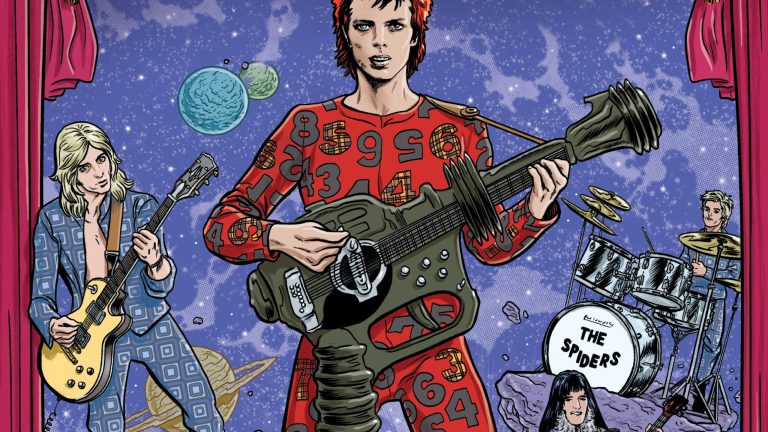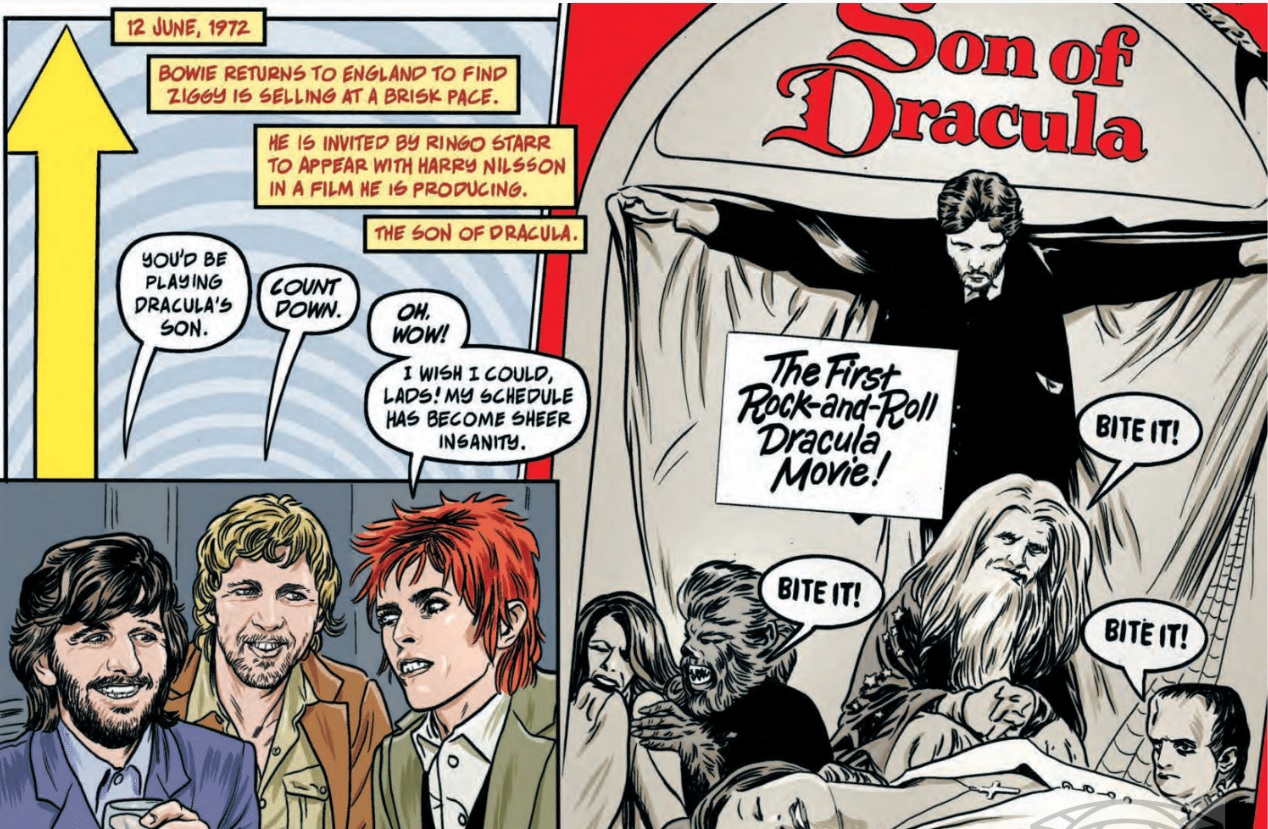BOWIE: Stardust, Rayguns, & Moonage Daydreams Review – David Bowie’s Memoirs Sparkle
David Bowie is presented as a very human superhero alien in a cinematic graphic novel.

BOWIE: Stardust, Rayguns, & Moonage Daydreams begins with a forward by Neil Gaiman called “If We Can Sparkle He May Land Tonight.” It recounts the author’s first contact with the third kind. David Bowie‘s songs were stories, he remembers, like the Gilbert and Sullivan ditties Gaiman preferred over rock and roll in his youth. He bonded with the rock star over the science fiction undercurrent in the music and image, and glorified him in his mind. Among his favorite memories is trekking to Victoria Station where the Thin White Duke arrived by special train before the 1975 Isolar Tour. Gaiman remembers the faux Bowies at the station, and the Station to Station albums scattered about to distract Bowie fans. The rest of the world was distracted by a blurred photograph which made it look like Bowie was giving a Nazi salute when it was enhanced. Such was the homo superior superpower of Bowie’s myth.
Insight Comics’ graphic novel is presented as a film directed by Mike Allred (Madman, Silver Surfer), who is also credited as co-screenwriter with Steve Horton (Satellite Falling). The illustrations by Mike and Laura Allred (Madman, iZombie) get her the credit as Technicolor cinematographer and the cinematic theme helps center the reading experience and nods to Bowie’s acting exposure. The book points out Bowie trained in mime and appeared in a few films before his career took off like Major Tom in a tin can. He also had to turn down an appearance, Son of Dracula, where he would have played Harry Nilsson’s son to Ringo Starr’s Merlin, due to studio commitments. BOWIE: Stardust, Rayguns, & Moonage Daydreams opens at the Hamersmith Odeon on July 3, 1973, when Bowie said goodnight to his Ziggy Stardust persona, but the film crossfades to 1962 just before the actual announcement is made.

At the start, Bowie is presented as a tireless and curious artist, a veteran of bands The Konrads, The Mannish Boys and The King Bees, hanging with young London musicians who would make up the Small Faces and ultimately T Rex. BOWIE: Stardust, Rayguns, & Moonage Daydreams doubles as Bowie’s memoir told against the rise and fall of his Ziggy Stardust persona, who comes across as a character conjured by the singer from the sky to bring his music to new life. Bowie is a superhero whose extraterrestrial exploits are made from the madness which runs in his family and the alchemy of the changing styles of rock and roll. His ears gobble up Velvet Underground, the Rolling Stones, the Who, and Pink Floyd, and his non-matching eyes catch the fiery fingers of Eric Clapton at night at the clubs. Forced to change his name to the strong sounding Bowie because David Jones is already singing for the Monkees, his first album debuts the same day as The Beatles‘ Sgt. Pepper’s Lonely Hearts Club Band, but doesn’t do quite as well.
read more: Why Mick Ronson is Essential to David Bowie’s Legacy
Taking inspiration from Stanley Kubrick‘s science fiction masterwork 2001: A Space Odyssey and Roger Vadim’s camp classic Barbarella, Bowie stars in the promotional film Love You Til Tuesday, which also features Hermione Farthingale, the girl with the mousy hair, in a segment. He meets Tony Visconti, the Brooklyn-born instrumentalist who would be a lifelong collaborator. The pair bond artistically over a viewing of Roman Polanski’s film Knife in the Water. Bowie finds his Jeff Beck in Mick Ronson. The first glam rock performance happens on Feb. 22, 1970, when David Bowie appears as Spaceman, Vicsonti is Hypeman, Ronson is Gangster Man and John Cambridge is Cowboy Man in the band The Hype at the Roundhouse in London. Nobody applauds when the band leaves the stage, but Marc Bolan eats it up.
read more: Exploring David Bowie’s Sci-Fi Fascination
If you’re a rock fan, you know all the characters in the book. Bowie’s career traversed the entire musical world in the short time it took for Ziggy Stardust to fall to earth. As a young artist, Bowie shops at the same stores as Freddy Mercury, shares stages with Peter Frampton and goodnaturedly ribs Marc Bolan, who will co-opt Tony Visconti, over tea. As he gains prominence he takes tea with Elton John, who Visconti passed on as a producer. There are some informational nuggets and gossip in the mix. The story throws in incidental tidbits like Bowie staying at the Warwick, same hotel the Beatles stayed at when they played Shea Stadium, when he was in New York to sign with RCA. Then adds details like how Iggy Pop got clean at the Warwick or how Bowie was taken straight to an Elvis Presley concert after one of his arrivals in the United States.
read more: The Man Who Fell to Earth: The Myopic Wonder of David Bowie’s Earth Oddity
Prepare yourself before reading. “Roll up your sleeves and show us your arms,” as a censored bit of promotion for The Man Who Sold The World advised. You might want a playlist of Bowie songs for backing music or for easy reference. Bowie’s early liftoff was propelled by Barbra Streisand’s cover of “Life on Mars” and Peter Noone of Herman’s Hermit’s rendition of “Oh You Pretty Things.” The illustrations are fantastic, conjuring the look of classic iconography as well as rock stardom. Many individual drawings could be comic book covers, others album posters. The biography is colorful and cosmic, following Bowie’s alter egos against the backdrop of iconic cultural influences like The Rocky Horror Picture Show, A Clockwork Orange, The Twilight Zone, even the Last Supper.
read more: David Bowie Was No Chameleon: A Sound and Vision Lookback
The novel illustrates Bowie’s love of happy accidents like a phone ringing through a vocal track and a botched take which can be saved with the right 12 string guitar, in the formation of his sound. Bowie defied classification, mixing mime with psychedelic music, forming an image through the parts he plays and mixing the surreal with motion picture futurism. Bowie’s artistic and commercial trajectory is paralleled by the rise and fall of Ziggy Stardust. The Spiders from Mars disintegrates as Bowie wrestles with his alter ego. The internal conflict changes the world. The final separation between the character and the artist is sad, but necessary. He’s saved the world, given us the Starman savior, grounded Major Tom and goes off for a few drinks, with ice.
BOWIE: Stardust, Rayguns, & Moonage Daydreams is a gift for David Bowie fans. It hit stands on Jan. 7, in time for Bowie’s 73rd birthday.
Culture Editor Tony Sokol cut his teeth on the wire services and also wrote and produced New York City’s Vampyr Theatre and the rock opera AssassiNation: We Killed JFK. Read more of his work here or find him on Twitter @tsokol.
Read and download the Den of Geek Lost in Space Special Edition Magazine right here!
